 | |||||
|
 | |||||
|
Mars Climate Orbiter - Aerobraking
Mars Climate
Orbiter MissionMission Overview
Launch
Dec, 11, 1998Cruise
Dec 11, 1998 - Sep 23, 1999Mars Orbiter Insertion
Sep 23, 1999Aerobraking
Sep 23, 1999 - Nov 25, 1999Lander Support
Dec 3, 1999 - Mar 1, 2000Mars Mapping
Mar 1, 2000 - Jan 15, 2002Relay
Jan 15, 2002 - Dec 1, 2004
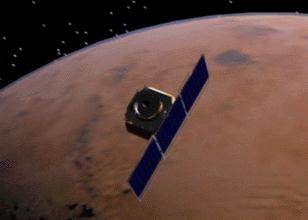
In aerobraking, a spacecraft is slowed down by frictional drag as it flies through the upper part of a planet's atmosphere. The technique was first tested by NASA's Magellan spacecraft at Venus at the end of its prime mission in 1994, and is being used by the currently orbiting Mars Global Surveyor. Mars Climate Orbiter will be starting from an orbit much lower than Mars Global Surveyor - with an orbit period only one-third as long - so it will require much less aerobraking. If Mars Climate Orbiter is launched within the first eight days of its launch period, it will be able to reach its final science-gathering orbit at least two weeks before Mars Polar Lander arrives.
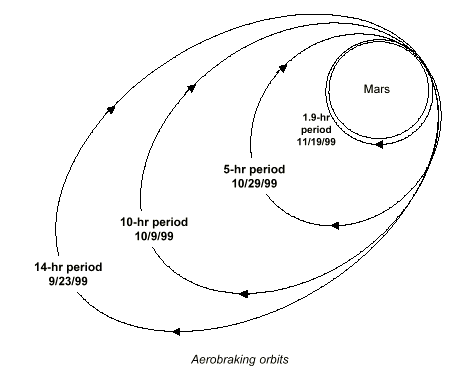
During each of its long, elliptical loops around Mars, the orbiter will pass through the upper layers of the atmosphere each time it makes its closest approach to the planet. Friction from the atmosphere on the spacecraft and its wing-like solar array will cause the spacecraft to lose some of its momentum during each close approach, known as an "aeropass." As the spacecraft slows during each close approach, the orbit will gradually lower and circularize.
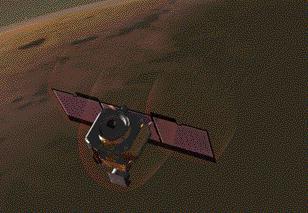
Before the beginning of each aeropass, the orbiter's solar wing will be braced against the body of the spacecraft for mechanical stability. The spacecraft therefore will not receive any solar energy until after the aeropass is over and the solar array can be turned again toward the Sun.
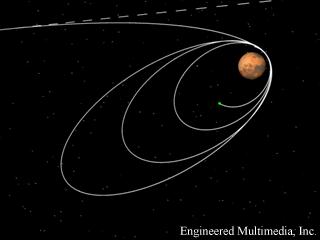
Mars Climate Orbiter may begin aerobraking within a day after it enters Martian orbit. The first thruster firing to adjust the orbit for aerobraking may be performed as early as the first time the spacecraft swings away from the planet after entering orbit. During the next several days, the flight team will fire the thrusters each time the spacecraft reaches the point in its orbit most distant from the planet. This will bring the point of its closest approach to Mars down within the planet's upper atmosphere.
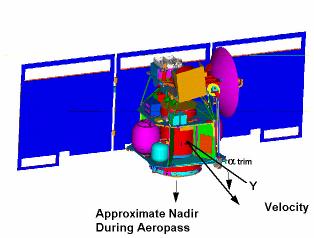
Mars Climate Orbiter In Aerobraking ConfigurationThe main aerobraking phase will begin once the point of the spacecraft's closest approach to the planet - known as the orbit's periapsis - has been lowered to within about 100 kilometers (60 miles) above Mars' surface. As the spacecraft's orbit is reduced and circularized over approximately 200 aeropasses in 57 days, the periapsis will move northward from 34 degrees north latitude to 89 degrees north latitude, almost directly over Mars' north pole. Small thruster firings when the spacecraft is most distant from the planet will keep the aeropass altitude at the desired level to limit heating and dynamic pressure on the orbiter.
Although the orbiter's transmitter may be on continuously during aerobraking, contact with Earth will not be possible during the aeropasses or when the spacecraft passes behind Mars as seen from Earth. As a result, the spacecraft will be out of contact with Earth for 45 to 60 minutes per orbit. Mars Climate Orbiter will be monitored and tracked during each orbit, but will sometimes share Deep Space Network antenna time with Mars Global Surveyor. Concurrent observations of the planet by Mars Global Surveyor will provide early warning of dust storms and other atmospheric changes, which could affect Mars Climate Orbiter's aerobraking.
The most challenging part of aerobraking will occur during what the flight team calls the "end game": the last few days of aerobraking, when the period of the spacecraft's orbit is shortest. At that time, aeropasses will be occurring most frequently and lasting longer than previous aeropasses.
The final science orbit will be a "late afternoon" orbit that takes the spacecraft over the Martian equator at approximately 4:30 p.m. local mean solar time on the day side of the planet, and at 4:30 a.m. on the night side of the planet.
Lander Support Phase
| Home | Mars Climate Orbiter | Mars Polar Lander | Deep Space 2 Microprobes |
| Welcome | Mailing List | Links | Credits |
For questions or comments on this website please refer to our list of contacts.